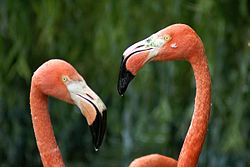American flamingo
| American Flamingo | |
|---|---|

| |
| Scientific classification | |
| Kingdom: | |
| Phylum: | |
| Class: | |
| Order: | |
| Family: | |
| Genus: | |
| Species: | P. ruber
|
| Binomial name | |
| Phoenicopterus ruber Linnaeus, 1758
| |
The American Flamingo (Phoenicopterus ruber) is a large species of flamingo closely related to the Greater Flamingo and Chilean Flamingo. It was formerly considered conspecific with the Greater Flamingo, but that treatment is now widely viewed (e.g. by the American and British Ornithologists' Unions) as incorrect due to a lack of evidence. It has also been known as the Caribbean Flamingo, but the species' presence in the Galápagos makes that name problematic. It is the only flamingo which naturally inhabits North America.
Distribution
The American Flamingo breeds in the Galápagos, coastal Colombia, Venezuela and nearby islands, besides the Guyanas and Cape Orange in Brazil. It also breeds in the Yucatán Peninsula of Mexico, and in the northern Caribbean in the Bahamas, Hispaniola, Cuba and the Turks and Caicos Islands. Most sightings in southern Florida are usually considered to be escapees, although at least one bird banded as a chick in the Yucatán Peninsula has been sighted in Everglades National Park, and others may be wanderers from Cuba. From a distance, untrained eyes can also confuse the Roseate Spoonbill with it.[1][2]


Its preferred habitats are similar to that of its relatives: saline lagoons, mudflats, and shallow brackish coastal or inland lakes. An example specific habitat is in the Petenes mangroves ecoregion of the Yucatán.[3]
Description
Like all flamingos, it lays a single chalky white egg on a mud mound, between May and August; incubation until hatching takes from 28 to 32 days; both parents brood the young for a period of up to 6 years when they reach sexual maturity. Their life expectancy of 40 years is one of the longest in birds.
120–140 cm (47–55 in) in length, the males weigh 2.8 kg (6.2 lb) and females 2.2 kg (4.9 lb) kg. Most of its plumage is pink, giving rise to its earlier name of Rosy Flamingo and differentiating adults from the much paler Greater Flamingo. The wing coverts are red, and the primary and secondary flight feathers are black. The bill is pink and white with a restricted black tip, and the legs are entirely pink. The call is a goose-like honking.
It is one of the species to which the Agreement on the Conservation of African-Eurasian Migratory Waterbirds (AEWA) applies.
Notes
- ^ University of Florida, Florida's Wading Birds: "Flamingos may be confused with the Roseate Spoonbill for a variety of reasons. Both species have relatively long legs, long necks, and pinkish plumage. Both also sift through the water with their bills when feeding. Despite these similarities, the two species are unrelated. The easiest ways to tell the two species apart are by the dark outer wing feathers (primaries) on the flamingo and both species' distinctive bill shapes."
- ^ Smithsonian Marine Station: "From a distance, [the roseate spoonbill] can be confused with the [flamingo], due to the similarity of body color in both species. However, the roseate spoonbill is generally smaller than the flamingo, with a shorter neck, and a longer, spoon-shaped bill."
- ^ World Wildlife Fund. 2010. Petenes mangroves. eds. Mark McGinley, C.Michael Hogan & C. Cleveland. Encyclopedia of Earth. National Council for Science and the Environment. Washington DC
References
- Template:IUCN2008 Database entry includes justification for why this species is of least concern
- Studer-Thiersch, A. 1975. Die Flamingos. pp. 239–245 in: B. Grzimek (editor): Grzimeks Tierleben. Vol. 7/1 Vögel. DTV (1980) München, nach Kindler Verlag AG Zurich 1975-1977.
External links
- Caribbean Flamingo from the IUCN/Wetlands International Flamingo Specialist Group
- Flamingo Resource Centre - a collection of resources and information related to flamingos
- 3D computed tomographic animations showing the anatomy of the head of the Caribbean Flamingo
- IUCN Red List least concern species
- Phoenicopteridae
- Flamingos
- Birds of the Bahamas
- Birds of Colombia
- Birds of Cuba
- Birds of Ecuador
- Birds of Guyana
- Birds of Brazil
- Native birds of Southern Mexico
- Birds of the Turks and Caicos Islands
- Birds of Venezuela
- Birds of the Yucatán Peninsula region
- Animals described in 1758
- National symbols of the Bahamas
- Birds of North America

